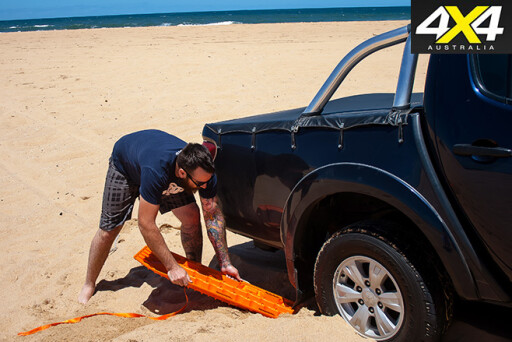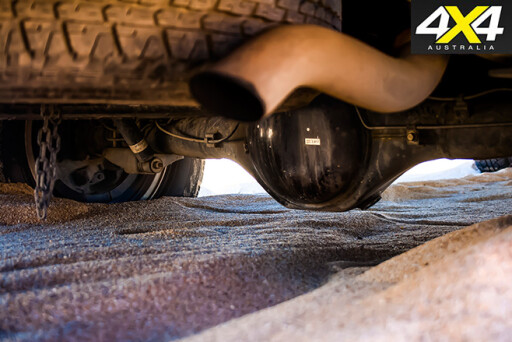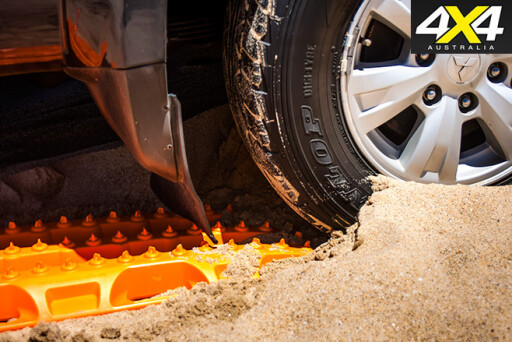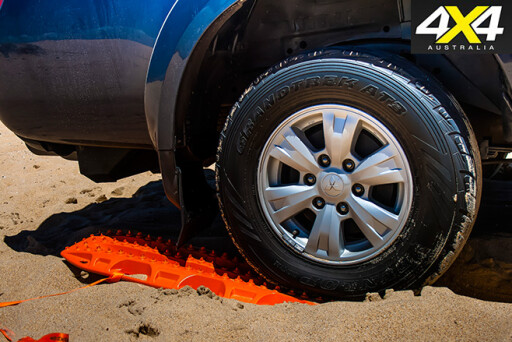
Quality four-wheel-drive gear isn’t cheap, especially when it comes to recovery gear such as winches.
In a perfect world we’d all be running high-mount winches with a slew of attachments and other recovery devices to get us out of any situation short of North Korea invading. But while the glorious leader’s army remains in Korea, things don’t necessarily need to get extreme.
In fact, depending on what 4x4 you own, it might even make financial sense to park it if you get bogged, hike back in to town and buy a new one, rather than maxing out the American Express on the required recovery gear.
With this in mind, it’s not surprising that we’re seeing traction boards like the MaxTrax popping up on every 4x4 both sides of the black stump.
 They cost about the same as two to three tanks of fuel depending on your tank, are easy to store, and are more versatile than a Swiss Army knife, albeit with slightly fewer attachments.
They cost about the same as two to three tanks of fuel depending on your tank, are easy to store, and are more versatile than a Swiss Army knife, albeit with slightly fewer attachments.
As is often the case in 4x4-land, many owners gloss over the full capabilities of the equipment they’ve bought, or the intricacies required for a simple recovery. Think of it like trying to use a clutch after only being taught to drive an auto.
The odd savant might pick it up quickly but the rest of us would be bunny-hopping down the road like an L-plater juiced up on Red Bull and No-Doze.
So over the next few pages we’ll be running through the step-by-step of a standard traction-board recovery with a set of MaxTrax, as well as a few other handy tricks you might not be aware of.
1. DON'T PANIC
You are stuck on the beach with the tide coming in, an irrational spouse in the passenger seat and the kids screaming in the back. It’s a pretty bad situation, but things can always get worse.
 In situations like this, and most others, the old adage “slow is smooth, smooth is fast” always holds true. By rushing, you’re more likely to overlook the basic components that can make a world of difference.
In situations like this, and most others, the old adage “slow is smooth, smooth is fast” always holds true. By rushing, you’re more likely to overlook the basic components that can make a world of difference.
2. ASSESS THE PROBLEM
Before you even get started, assess the situation, see why you’re stuck and find what’s holding you back from forward progress.
 An axle or chassis planted into the ground won’t take much fixing with a shovel but can leave you spinning your wheels on the traction boards if you don’t take care of the situation. Get out, look your 4x4 over and then get to work to set it free from what is holding it.
An axle or chassis planted into the ground won’t take much fixing with a shovel but can leave you spinning your wheels on the traction boards if you don’t take care of the situation. Get out, look your 4x4 over and then get to work to set it free from what is holding it.
3. DIG A TRENCH
Preparation is paramount. The amount of time you work on making it an easy recovery directly relates to how long it’ll take you to get unstuck. We’ve all seen muppets get stuck before; they quickly throw a set of MaxTrax somewhere in front of their wheels and then dump the clutch, ripping all the lugs off the boards without actually getting unstuck. In recoveries there are no shortcuts to success.
 Grab a long-handled shovel or your traction boards if they have a built-in shovel, and start clearing a path ahead of the wheels. You’ll need to build a gentle ramp up and out of where you’re stuck. Sand is easy digging, so don’t hold back. With a trench, or ramp dug in front of each tyre, it should look like you could drive out on your own; the traction boards just give you the grip to gain your momentum back.
Grab a long-handled shovel or your traction boards if they have a built-in shovel, and start clearing a path ahead of the wheels. You’ll need to build a gentle ramp up and out of where you’re stuck. Sand is easy digging, so don’t hold back. With a trench, or ramp dug in front of each tyre, it should look like you could drive out on your own; the traction boards just give you the grip to gain your momentum back.
4. SET THE RECOVERY BOARDS
With a trench dug out under each tyre and the diffs and chassis clear of any obstructions, it’s finally time to reach for the MaxTrax – it shouldn’t take more than a few minutes to get to this point. Lugged traction boards use the gaps between tread blocks to bite on and then spread the load out over a much larger area (the size of the board). To get them to bite you want at least two rows of lugs under the leading edge of the tyre, allowing it to pull the board underneath and you to drive out.
 The downside of this design is, with too much weight or wheelspin, the boards can be pushed under the surface, never to be seen again. Some boards come fitted with straps that you can lay out to the side and follow back to the board after it’s been buried.
The downside of this design is, with too much weight or wheelspin, the boards can be pushed under the surface, never to be seen again. Some boards come fitted with straps that you can lay out to the side and follow back to the board after it’s been buried.
5. DRIVE OUT
If you have four boards, fantastic, but you can get by with two boards in most recoveries. From here, you’ll need to keep a clear area behind the 4x4 and begin recovering yourself. The lugs on the boards are considered sacrificial. They’re made thin to ensure they fail instead of ripping your tyres to shreds. Because of this it’s vital to perform the recovery with as little wheelspin as possible, although it is sometimes unavoidable.
 To keep wheelspin down, select low range and gently apply the throttle. One of a few things will happen: you’ll climb straight out; the boards will get pulled under and then you’ll climb out; or you’ll still be stuck. If you don’t climb out immediately, the trenches may be too steep or the boards may not be far enough under the tyres. Dropping tyre pressures to low double digits may also be required.
To keep wheelspin down, select low range and gently apply the throttle. One of a few things will happen: you’ll climb straight out; the boards will get pulled under and then you’ll climb out; or you’ll still be stuck. If you don’t climb out immediately, the trenches may be too steep or the boards may not be far enough under the tyres. Dropping tyre pressures to low double digits may also be required.
Getting bogged
It sucks. Getting seriously bogged sucks even more. The first thing most people do when they realise they’re getting bogged is push the accelerator to the floor and try to drive out. It might work; it also might bury you up to your axles adn sills in sand or mud, leaving you on the business end of a shovel for the next few hours.

You’ll normally stop when your axles or chassis rails hit the ground and you can’t go any farther down. This essentially anchors you to the ground, turning what could have been a mundane recovery into a day you won’t soon forget, and not in a good way.
Other uses for traction boards

- Bridge over washouts
- Ramp over logs, rock ledges, undercut steps
- Slippery mud
- Base for jacking
- Levelling a 4x4 for a roof top tent or camping set-up
- Slippery hill climbs
If you want more info on 4x4 recoveries check out:
- part 1 of our 4x4 recovery guide: the basics
- Part 2 of our 4x4 recovery guide: recovery kits
- Part 3 of our 4x4 recovery guide: the snatch

COMMENTS